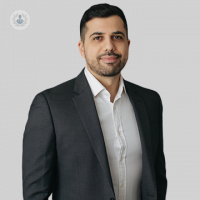ACL reconstruction explained
Written in association with:ACL tears occur frequently due to playing sports, and as a result, ACL reconstruction is a procedure which orthopaedic surgeons perform regularly. Leading orthopaedic surgeon Mr Osama Aweid explains everything you need to know about the procedure.

What is the ACL and how can it be affected?
The ACL, or anterior cruciate ligament, is a major ligament in the knee that helps stabilise the joint and control movement. It can be injured during sports that involve jumping, pivoting and rapid change of direction. Commonly, these sports are skiing, football, rugby and tennis.
When should I have surgery for my ACL?
An ACL injury can result in the knee becoming unstable. Incidences of the knee giving out/giving way can occur during day-to-day activities such as turning on the spot. In other cases, the knee only gives out/gives way during certain sports. Patients with knee instability during daily activities or those keen to return to certain sports can consider ACL surgery to improve the stability of knee.
What happens during an ACL reconstruction? How is it performed?
During an ACL reconstruction, a surgeon replaces the damaged ACL with a new ligament. This is done using a graft, which is usually taken from the patient's own body, such as from the patellar tendon or the hamstring. The procedure is performed arthroscopically, meaning that the surgeon makes small incisions in the knee and uses small instruments to access the joint.
What type of graft is usually used?
A common graft used for ACL reconstruction is the hamstring tendon autograft. The tendon autograft is taken from the patient's own knee through a small incision in the front. There are some other options for grafts, including the quadriceps tendon or the patella tendon.
The choice of graft depends on several factors such as:
- The patient’s age.
- The patient’s activity level.
- The sport they play.
- Whether the ACL surgery in the knee is being performed for the first-time or if it is a redo operation.
Based on recent research, we now know that the risk of an ACL re-injury can be reduced in certain patients by adding a procedure called a lateral extra-articular tenodesis (LET). This procedure involves protecting the ACL graft using a strip of tissue from the iliotibial or IT band on the outer side of the knee.
Patients who benefit from a LET include those with generalised hypermobility in their joints or high grade ACL laxity on clinical assessment.
What can patients expect after the procedure? Are there any side effects?
After the procedure, patients can expect to experience some pain and swelling in the knee, which can be managed with medication and physical therapy. There may also be some stiffness and loss of strength in the knee, but these symptoms typically improve with time and rehabilitation.
What is recovery like?
The recovery period after an ACL reconstruction can vary depending on the patient, the type of surgery, and the type of graft used. A structured physical therapy programme is essential to help regain strength and mobility in the knee. The patient’s ability to return to competitive sports will take 12 months and it is crucial that they do not return any sooner than this, in order to minimise the risk of an ACL re-injury.
How much functionality is recovered after an ACL reconstruction?
It is important to note that all patients with an ACL injury have a risk of developing knee arthritis in future regardless of whether they undergo surgery or not. Surgery does however help restore stability and range of motion to the knee, allowing many patients to return to normal activities and sports. It also prevents the damage to the knee that can occur from the knee repeatedly giving out.
If you require ACL reconstruction and would like to book a consultation with Mr Aweid, simply visit his Top Doctors profile today.


